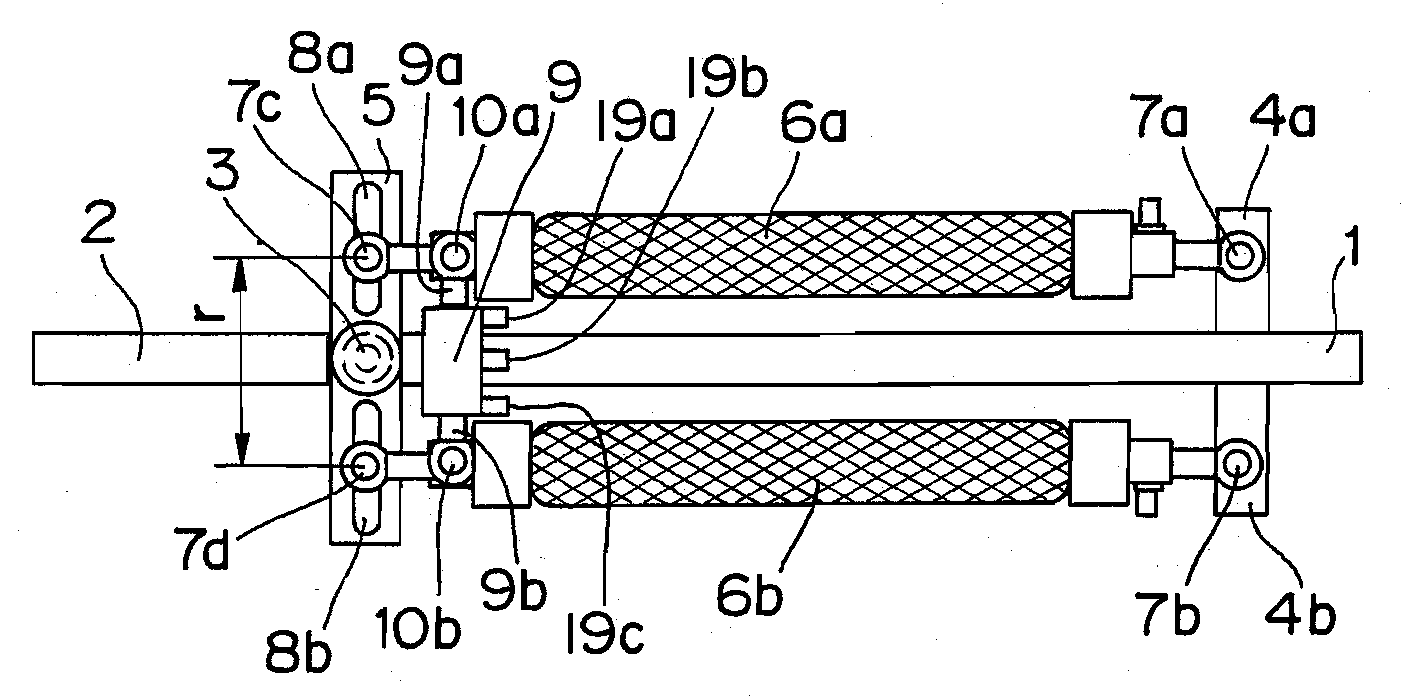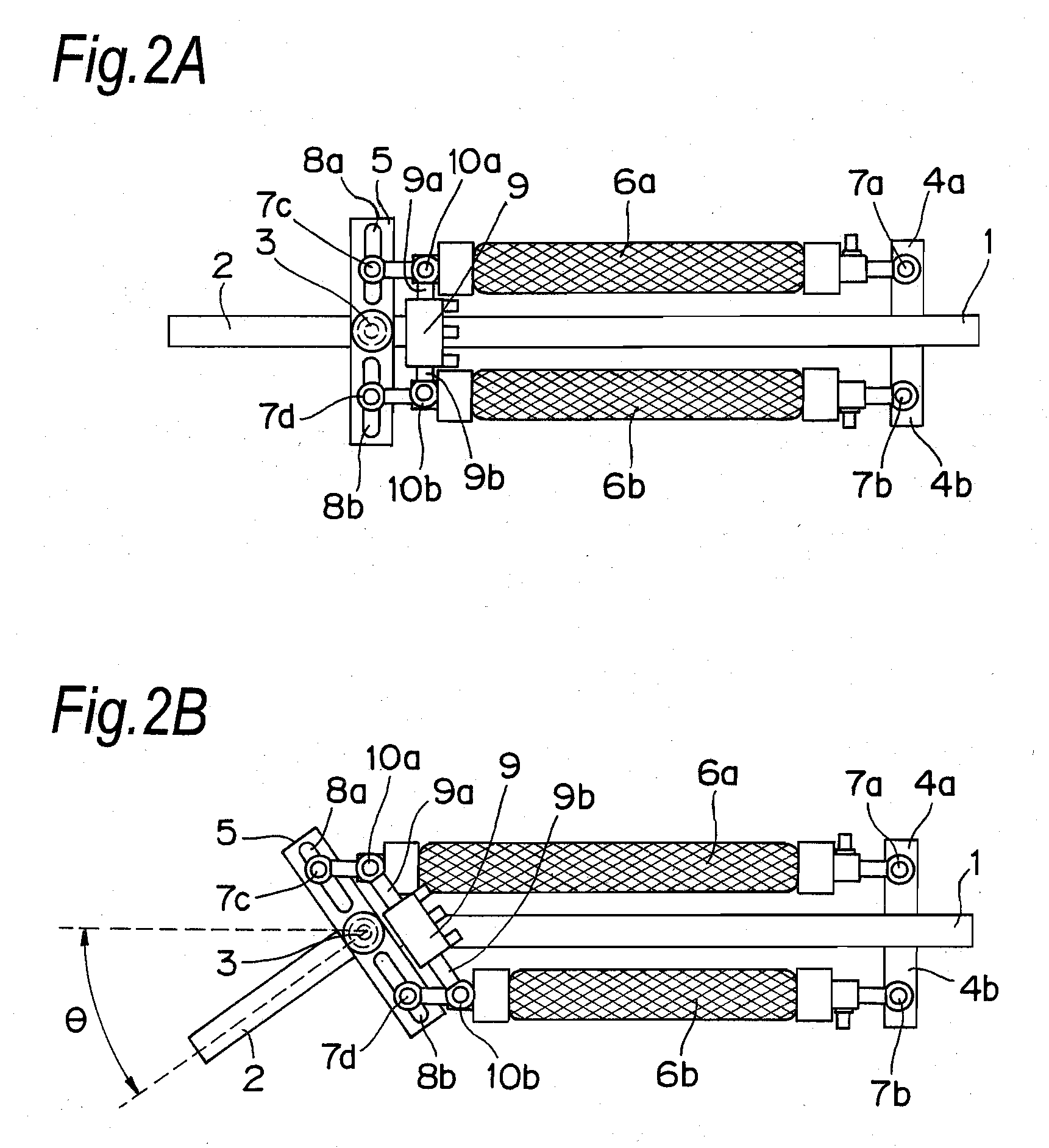Joint driving device
a driving device and driving shaft technology, applied in the direction of joints, manipulators, program-controlled manipulators, etc., can solve the problems of reduced control accuracy, inability to perform operations, configuration is not capable of generating variable torques with a certain translational force, etc., to achieve flexible and continuous switching, higher outputs, and higher reliability
- Summary
- Abstract
- Description
- Claims
- Application Information
AI Technical Summary
Benefits of technology
Problems solved by technology
Method used
Image
Examples
first embodiment
[0093]FIG. 1 is an overall view illustrating the configuration of a joint driving device according to a first embodiment of the present invention. In FIG. 1, numeral 1 denotes a rod-shaped first configuration member and numeral 2 denotes a rod-shaped second configuration member. The first configuration member 1 and the second configuration member 2 are coupled to each other at their one ends through a rotational joint 3 so that the first configuration member 1 and the second configuration member 2 are rotatable relative to each other. A pair of plate-shaped actuator supporting members 4a and 4b are placed on the other end of the first configuration member 1, such that the plate-shaped actuator supporting members 4a and 4b are located along the direction orthogonal to the axial direction of the first configuration member 1 and opposite to each other. Near one end of the second configuration member 2, there is placed a single plate-shaped actuator driving-force transfer member 5, alon...
second embodiment
[0129]FIGS. 9A and 9B are views illustrating the configuration of a joint driving device according to a second embodiment of the present invention. The joint driving device of FIGS. 9A and 9B is different from the first embodiment in components which will be described later, while the other portions are the same as those of the first embodiment. These common components will be designated by the same reference characters as those of the first embodiment and detailed description thereof will be omitted.
[0130]In FIGS. 9A, 9B, and 10, a numeral 45 is an elliptical-plate shaped cam which is placed such that the center shaft thereof is coincident with the rotation shaft of a rotational joint 3 and the cam is not relatively rotatable with respect to a first configuration member 1. A numeral 46 is a spring which is coupled to the end portions of the elastic body actuators 6a and 6b near the rotational joint 3 through rotation joints 47a and 47b. Further, the end portions of the elastic body...
third embodiment
[0137]FIG. 11 is a perspective view illustrating the configuration of a joint driving device according to a third embodiment of the present invention. In FIG. 11, a numeral 50 is a cam driving actuator which is operated under the control of the control computer 24 and is constituted by, for example, a rotational motor such as a DC servo motor, or a rotation type pneumatic actuator. The cam driving actuator 50 is secured to the actuator driving-force transfer member 5, and a cam 45 is secured to the output rotation shaft of the cam driving actuator 50. The rotational angle of the cam 45 relative to the actuator driving-force transfer member 5 can be controlled under the control of the control computer 24, through the cam driving actuator 50. The other configurations are similar to those of the aforementioned second embodiment and, therefore, the common components will be designated by the same reference characters and description thereof will be omitted.
[0138]In the joint driving dev...
PUM
 Login to View More
Login to View More Abstract
Description
Claims
Application Information
 Login to View More
Login to View More - R&D
- Intellectual Property
- Life Sciences
- Materials
- Tech Scout
- Unparalleled Data Quality
- Higher Quality Content
- 60% Fewer Hallucinations
Browse by: Latest US Patents, China's latest patents, Technical Efficacy Thesaurus, Application Domain, Technology Topic, Popular Technical Reports.
© 2025 PatSnap. All rights reserved.Legal|Privacy policy|Modern Slavery Act Transparency Statement|Sitemap|About US| Contact US: help@patsnap.com



